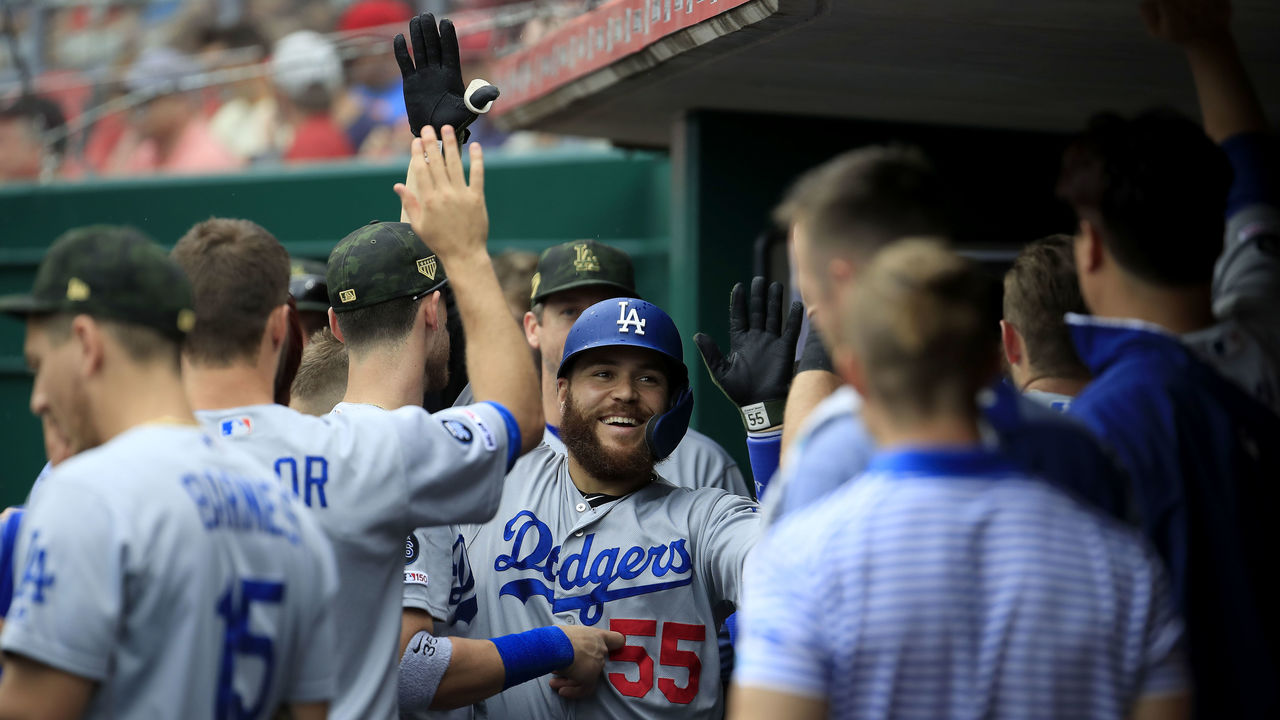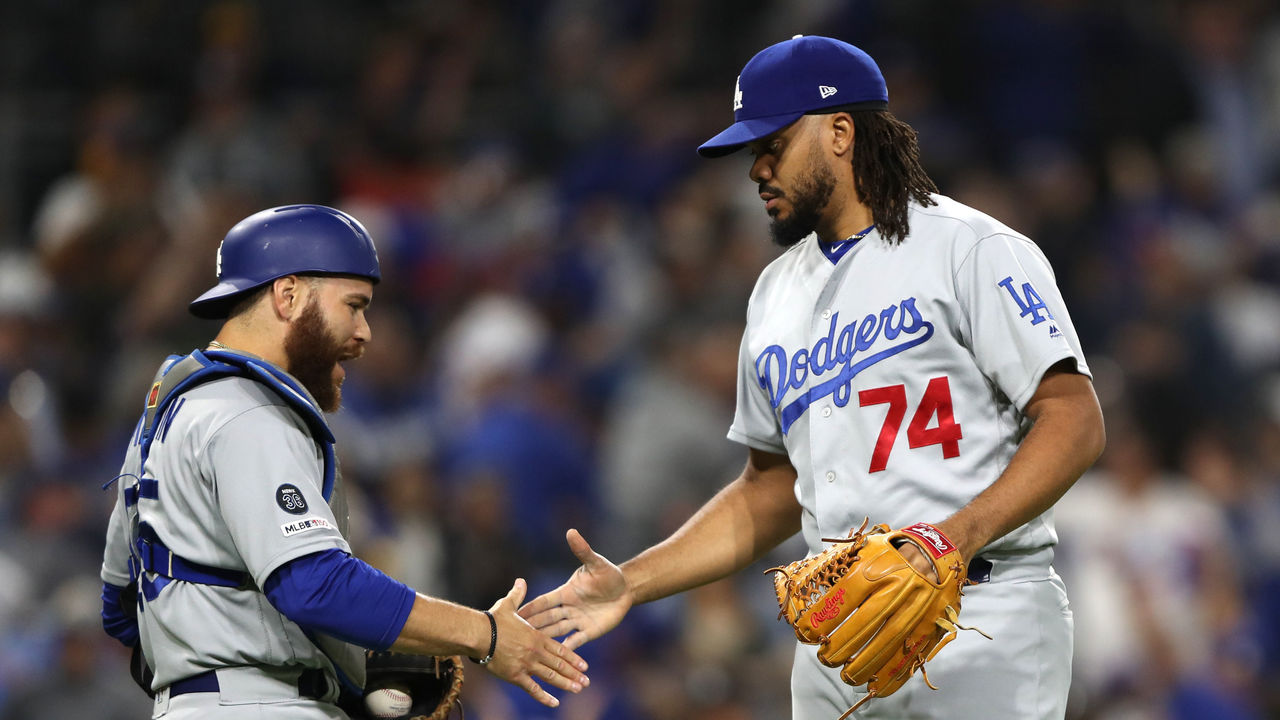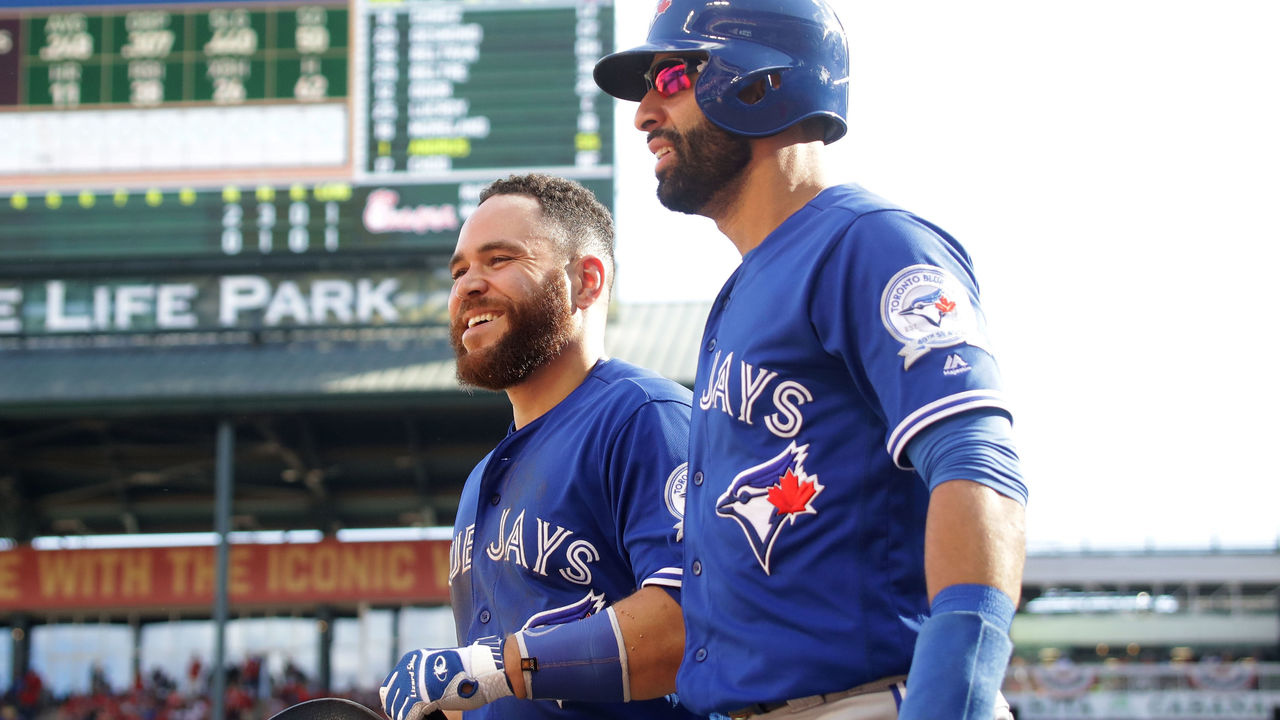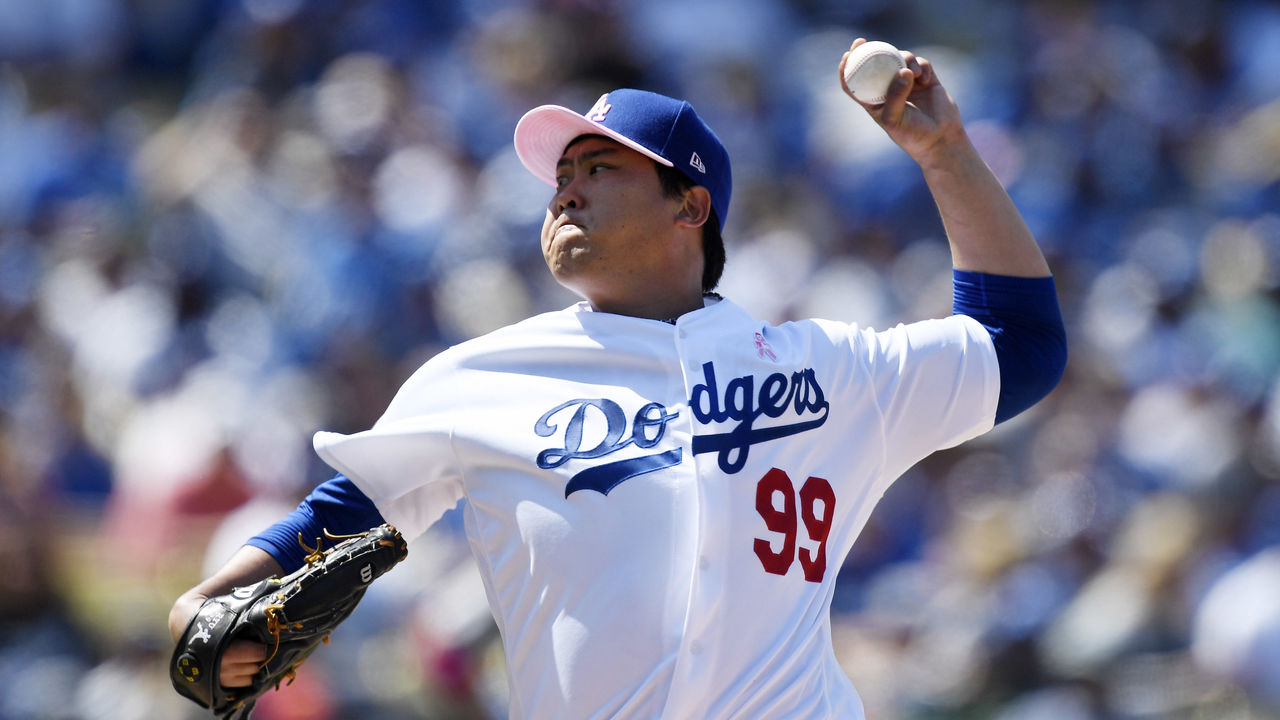Dodging the advance of time, Russell Martin returns to his roots
LOS ANGELES - As he jogged up to the pitcher's mound following yet another successful day of duty behind the plate, Russell Martin double-tapped his chest protector and pumped his fist. He and Kenta Maeda shared few words - the only common language between them is baseball - but there would be nods and smiles after a 2-0 win over the San Diego Padres.
It was a warm Wednesday in the City of Angels and the Dodgers had capped off yet another shutout, their third in a four-game span with Martin framing the corners.
In Martin's next start four days later, Hyun-Jin Ryu threw 7 1/3 scoreless innings. Again, Martin would need a translator to congratulate the South Korean-born Ryu on a job well done.
That is why Martin was brought back via an offseason trade with the Toronto Blue Jays. Not to remind anyone of his first go-round in L.A., when he scored two All-Star appearances, a Gold Glove, and a Silver Slugger in his first five big-league seasons. Not to be the brash, confident backstop who came up with a horde of other splashy youngsters.
But to speak one language, the language of baseball, in the Dodgers' continuing quest to win the World Series for the first time since 1988.

When you get a little older, you start to realize the importance of a good clubhouse conversation. It can change an at-bat, which can change an entire game.
A few weeks back, Martin was sitting in the clubhouse, chopping it up with a few teammates. He specifically remembers chatting with David Freese and Enrique Hernandez; the two veteran infielders asked him why longtime closer Kenley Jansen was staying away from his two-seam fastball, imploring Martin to call it.
Freese doesn't recall the conversation - there are so many in a 162-game season - but Martin trusts his memory of the talk because he listened to them, and it worked.
The Dodgers were nursing a 7-6 lead heading into the bottom of the ninth at Petco Park on May 4. Manager Dave Roberts summoned Jansen, the only teammate remaining from Martin's first stint with the franchise besides Clayton Kershaw.
The closer had been in a bit of a funk in April, with an ERA over 3.00 (his career ERA is under 2.30) and three home runs allowed in his previous six appearances. First up, Jansen would have to tangle with Manny Machado, the Padres' prized offseason acquisition.
After strolling to the mound to confer with Jansen before the start of the inning, Martin felt emboldened.
"Everyone facing Kenley was expecting this cut off the ball," he said of Jansen's signature pitch, the cutter. "They were going in there hunting for it. It's such a good pitch, it's hard to hit even if you're looking for it. But a guy like Machado, you make one mistake, and he's looking for it? You're not getting that ball back."
Martin prodded Jansen to go with his two-seamer, if only to get Machado off the plate a bit. Martin didn't think Jansen's cutter was commanding respect from hitters at that point, least of all from one with Machado's bravado.
"If I hear something and it makes sense to me, I’m not afraid to try it," Martin said.
Jansen thought for a moment and nodded his head. If Martin felt confident, so did Jansen.

The ball bore in on Machado's belt buckle and froze him. "Now he doesn't feel like he can attack it low and away and go hunting," Martin explained. "Machado stepped out and he was like, 'Oh crap,' and you could tell he was processing something that wasn't in his mindset before. He was thinking cutter the whole time because 95 percent of the time, that's what he's going to get."
Machado lunged at the next pitch, a cutter off the plate outside, and lofted a pop foul to Max Muncy at first base.
Asked to recall one time when Martin's suggestion - culled from the data stored in his brain - overruled the Dodgers' vaunted analytics, Jansen pointed to that very pitch.
"I probably would've gone with my bread and butter, but I went with the two-seamer and it changed the whole at-bat," Jansen said. "Martin knows what he's doing. He has a feel for it."
Thirteen years after he made his debut in Dodger Blue, Martin's now-prodigious beard is starting to show a few gray hairs. He requires regular maintenance on two body parts that shall remain nameless. He uses a hula hoop so often to stretch his back that he could compete against any middle schooler.
Yet he remembers his first game like it was yesterday.
Martin laughs as he is taken back to 2006, the night the bull-headed, bouncy 23-year-old made his major-league debut. It happened to be Cinco de Mayo. "The crowd's already feeling pretty good. Everybody's been day-drinking. They're super high-energy. I'm freaking out. Nervous and excited," he said.
"It's my first day, and we've lost five in a row, it's Cinco De Mayo, and Nomar (Garciaparra) says we're going to have a shot of tequila before the game today. It's my first freakin' game, dude. I'm like, 'A shot of tequila, what the f---?'
"We do it, win the game, I went 2-for-4 with a couple RBIs, caught Derek Lowe, who went eight innings and almost threw a shutout, and it was an unbelievable moment."
The Dodgers won four more in a row - each victory preceded by more shots of tequila - and 18 of their next 23 games with Martin installed as their new starting catcher, pulling themselves out of an early-season 12-17 hole. Los Angeles advanced to the playoffs. In 2007, Martin won a Silver Slugger and Gold Glove, and also became the first Canadian-born catcher to start the All-Star Game. He made the Midsummer Classic again a year later (catching 10 innings) and helped lead the Dodgers to back-to-back National League Championship Series appearances in 2008-09.
After a down year in 2009 and a worse year in 2010, ended prematurely by a torn labrum in August, Martin was non-tendered by general manager Ned Colletti, allowing him to become a free agent. Martin signed with the Yankees, with whom he'd earn a third All-Star appearance and two playoff berths. Then he joined the Pittsburgh Pirates, helping them to the playoffs in 2013 and to the wild-card game in 2014. He returned to his native country in 2014 with a five-year, $82-million contract from the Blue Jays.

In 2015, at the age of 32, Martin hit a career-high 23 home runs and drove in 77 runs. More importantly, Toronto advanced to the American League Championship Series for the first time in 22 years. A year later, Martin hit .231 but supplied 20 home runs with 74 RBIs as the Blue Jays advanced once more to the ALCS.
Then the wheels came off. Battling myriad neck, back, and shoulder injuries, Martin hit .221 in 91 games in 2017 and followed that up with career worsts across the board - a .194 batting average, 18 extra-base hits, and 25 RBIs in 90 games. By the end of last year, he'd been planted on the bench in favor of youngsters Danny Jansen and Reese McGuire.
The Blue Jays were ready to clear Martin's roster spot, and they were willing to eat more than 80 percent of the $20 million they owed him in the final season of what had been a franchise-altering contract. The Dodgers acquired him Jan. 11.
Martin vowed to be better at the plate, singling out his launch angle as an area for improvement. Last season, his ground-ball rate hit a career-worst 51.2 percent while his line-drive rate was a career-worst 14.1 percent. This season, those rates are at or near his career bests: a ground-ball rate of 46.7 percent and a line-drive rate of 24.4.
Through his first 20 games this season - which were interrupted by a 20-day stay on the disabled list with lower back inflammation - Martin is batting .264 with a .397 on-base percentage and a .812 OPS, his best since 2014 (his last season in Pittsburgh) and the third-highest of his career.
But, of course, Russell Martin wasn’t brought back to Los Angeles for his bat.
For Martin, the key is communication, even if there is a language barrier.
Watching him work the strike zone with Ryu is a thing of beauty.
Ryu burst onto the scene with the Dodgers in 2013-14. He went a combined 28-15 with a sub-3.20 ERA, only to be felled by back, shoulder, and elbow injuries that cost him all but one start in 2015-16. This season, he's emerged as perhaps the best starter in MLB. His 1.65 ERA leads the majors and his 0.83 WHIP is second only to Justin Verlander among starters. His 0.55 walks per nine innings is nearly twice as good as the next best in baseball, Zack Greinke.
Martin has caught seven of Ryu's 10 starts this season, including all five in May. Since May 1, Ryu is 4-0 with three earned runs, 29 strikeouts, and only two walks in 38 innings. The highlight was an eight-inning, one-hit, nine-strikeout masterpiece against the Washington Nationals on May 12, three days before Maeda's gem against the Padres.
"Russell works really hard preparing, and it makes it a lot easier when you can drive a pitcher and he can execute," Dodgers manager Dave Roberts said after Ryu's near no-no. "The changeup he was calling when he needed to, keeping the hitters honest. They were in rhythm the entire day and a lot of credit goes to Russell. That's been a battery for three, four, five starts, and that kind of rapport and consistency is playing out."
Ryu added: "Russ being the veteran, he has a very good understanding of what I want to do, and we communicate very well. Having him behind the plate definitely helps."

Martin and holdover Austin Barnes form the Dodgers' catching tandem. Yasmani Grandal was the Dodgers' No. 1 catcher last season, hitting 24 home runs and starting 110 games behind the plate. But his poor defense sent him to the bench in the playoffs. L.A. extended the standard $17.9-million qualifying offer at the end of the season, but Grandal declined and ended up signing a lesser one-year deal in Milwaukee.
Losing Grandal hasn't seemed to affect the Dodgers' place in the standings. Combining Barnes' experience with the franchise's advanced analytics and Martin's 13 previous seasons in the bigs has been a boon for the team, which owned the best record in the National League (35-18) entering Monday's games. L.A. is 10-5 in Martin's starts. Pitchers in those games have a 3.22 ERA compared to 3.59 when Barnes or Rocky Gale starts.
After he was acquired by the Dodgers, Martin quickly went to work learning the pitchers' tendencies.
"You could tell from the second you met him how excited he was to be here and how anxious he was to get to know the pitchers," right-hander Ross Stripling said. "You think about what we're doing with the analytical side of baseball, and he brings in a little bit of the old school. My first start against the Diamondbacks, I'd never seen Adam Jones before." Jones, a longtime member of the Baltimore Orioles, was very familiar to Martin after his years in the AL East.
"He comes up to the mound and he's like, 'Dude, I got Adam Jones,'" Stripling said. "That was cool. He does the scouting, he's very prepared, but he has the old-school feel, like, 'I know what your strength is, I've seen these guys, I know their weaknesses, we're going to get after him.'
"One hundred percent that just fires you up."
Martin, of course, does his fair share of studying. He goes through every opposing lineup on video, three or four at-bats against the day's starter, before every game. He takes what he needs and has learned to dismiss the rest.
"We get all this info and Russ gets it, too, and looks at it, but he's a guy who trusts his gut," Stripling said. "... He's lasted for as long as he has for a reason. You can trust him wholeheartedly to do a good balance and take what's good and trust in his own computer. In real time, he's seen these guys, many, many times."
Asked if he's a different person this time around with the Dodgers - if the game of baseball has diminished in importance as he's aged and softened and become a father - Martin is frank.
"In the grand scheme of things, a lot of things are way more important than baseball," he said. "It's entertainment. My whole outlook on life has changed. It's a pastime. I feel like it's good for mental health - you go to a game, and if you want to cheer for somebody, great, and you want to rip on somebody, great. It's therapeutic.
"Teachers, people who have a direct impact on your children every single day, they're important. I get that we're role models, and that can be impactful, but sports in general - it's just sports, man."
That’s about a 180-degree turn from the cocky cub catcher who alienated his pitchers with stare-downs at the mound.
"I was tougher to get along with early on," he said. "I was more hardcore. Super intense. Not violent, but very aggressive, even with pitchers. I just wanted them in fight mode all the time. Instead of talking mechanics or game planning, it was just, 'Snap out of it, let's f------ go.'"

In Martin, the Dodgers have found an older and wiser reboot. Russell 2.0.
"The competitive spirit is never going to go away," he said. "It's how I process it. I look at our young guys like (Alex) Verdugo, who can live and die with every at-bat, and I remember. I remember being that kid. I think over time, I just conserved my energy. I'm going to have another at-bat, and I'm going to get it done next time."
His recent duel with the Padres was a case study in that kind of wisdom, which only comes with experience and perhaps the onset of crow's feet.
His first at-bat against San Diego starter Matt Strahm? Not pretty. A high check-swing strikeout. His second? A meek pop-up to short. His third? A twisting, off-balance K.
Then, in the bottom of the eighth inning, Martin drove a 92-mph sinker from reliever Craig Stammen to left field and scooted in for a double, his first extra-base hit since early April.
Rounding first base, he bounded toward second, looking nothing like 36 and more like 23. Those days are still fresh in his mind.
"We had a little bit of a crew come up at the same time," Martin said of those late-2000s Diaper Dodgers, a group that included Kershaw as well as Matt Kemp, Andre Ethier, and James Loney. "It felt like you were moving up to the big stage and you had your brothers who you were in the trenches with. I mean, this was all I knew. This organization. This was the big leagues for me.
"I always knew it was special, but you don't realize how special it really is until you go to different places," he said. "It's really special when you come back and get to relive it again."